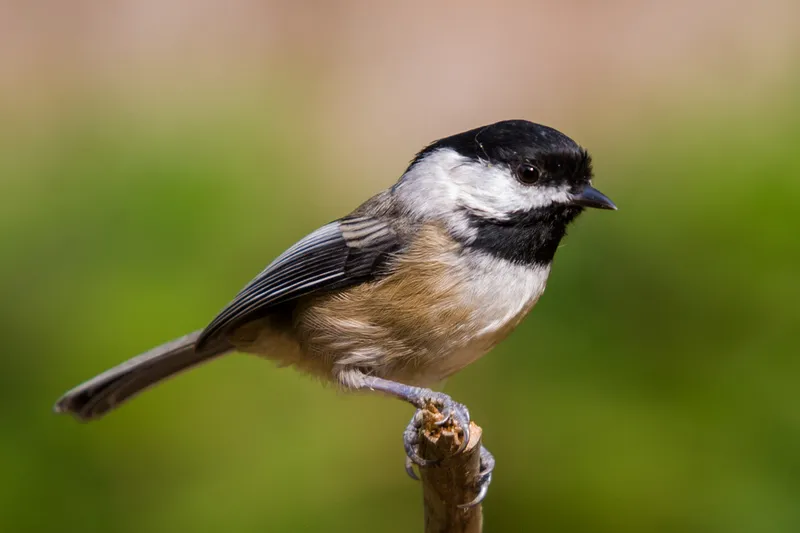Fifteen Common Garden Birds
Trees, shrubs and flowers attract birds to gardens and a bird bath and bird feeder will make your yard even more popular. Here are some of the common birds you might encounter. To learn more about the birds in the Greater Vancouver Bird Celebration, check out the Bird Celebration events happening May 14-31, 2022.
Black-capped chickadee
You will probably hear ‘chick-a-dee-dee-dee’ before you see a Black-capped Chickadee. In spring, you might also hear its ‘fee-bee’ song. One of the most common and perennial favourite garden birds, the chickadee was the City Bird for Vancouver in 2015. The Black-capped Chickadee frequents gardens and woodlands throughout the year in Vancouver. Insects, seeds and nuts make up its food. Chickadees nest in holes in trees they excavate and will use nest boxes.
House sparrow
Listen for ongoing chirps in urban areas and you will likely see House Sparrows. It is an introduced species that has taken to gardens and city streets of Vancouver. House sparrows feed mostly on the ground around the garden and streets. The male house sparrow has a grey crown, black bib, white cheeks and chestnut nape. House sparrows are year-round residents in Vancouver. Nests are built in cavities in buildings and nest boxes.
European starling
Squeals, chirps and mimicked bird calls coming from a tree will usually reveal a European Starling. It is an introduced species that lives year-round in Vancouver. Flocks will sometimes descend into gardens to feed at bird feeders and on insects on the ground. Starlings eat insects and fruits. Nests are built in cavities and spaces in trees, buildings, and street lights. Starlings form large flocks in winter that gather at roosts under bridges and wood lots.
Northwestern crow
The ‘caw’ of the crow rings out in every neighbourhood. The Northwestern Crow is a native resident bird found throughout the city. Nests are made from twigs and built-in trees. Food includes insects, fruit, and scraps. Following breeding, most crows from Vancouver fly to an evening roost near Still Creek in Burnaby.
American robin
From a treetop the ‘cheer-up cheerily cheer-up’ song of the American Robin rings out every spring morning in gardens and parks in Vancouver. The red breast of singing makes the American robin one of the most conspicuous birds in the city. Robins build nests of grass and mud in shrubs and trees. Their food is mostly insects, earthworms and fruit.
Song sparrow
Song sparrows live up to their name with a loud regular song in spring and summer. Shrubs and forest edges are its haunt and it readily visits bird feeders. Nests are small compact grass lined cups hidden from sight in shrubs. Song sparrows are common to gardens and parks.
Northern flicker
The flicker gets its name from its ‘flicka-flicka-flicka’ call. In spring, it drums on roof flashing, hard wood or any other surface that resonates loudly. Northern Flickers are woodpeckers identified by their orange under wing and tail. They are widespread year-round denizens of the city where they inhabit gardens, suburban streets and forests. Flickers eat ants that they hunt along the ground and insect larvae found in snags. Their nest is built in holes in trees that they excavate using their bills.
Violet-green swallow
The Violet-green Swallow is one of the first birds to arrive in spring and first to depart in summer. The swallow is mostly found in residential areas where it perches on telephone wires or flies overhead. Nests are built in cavities in buildings and in nest boxes placed in open areas high above the ground. Swallows eat flying insects.
House finch
Melodious is probably a word to describe the song of the House Finch. It is a year-round and widespread resident in Vancouver gardens and parks. The male is either red or orange on the head and breast while the female is streaked with brown feathers. Nests are small cups of twigs and grasses built in shrubs. Finches are mostly seed eaters and take readily to bird feeders in gardens.
Bushtit
The Bushtit frequents gardens and forest edges throughout the year in Vancouver. They build a distinctive nest of moss, lichen and spider webs suspended from the ends of branches. After breeding, flocks of bushtits roam neighbourhoods in search of insect larvae and bird feeders, especially those with suet feeders.
Anna’s hummingbird
The Anna’s Hummingbird is a recent and increasingly common backyard bird in Vancouver. Nests are built on the ends of branches between mid-winter until late summer. Hummingbirds take readily to hummingbird feeders and flowers such as Oregon grape, fuschia, and crocossmia.
Steller’s jay
The harsh ‘jay jay jay’ call of the Steller’s Jay is heard year-round in Vancouver especially in autumn and winter when jays are most numerous. The blue back, wings and sides and black head with a crest is unmistakable. Jays build twig nests hidden away in shrubs and trees. They eat insects and nuts, take other birds’ eggs, and readily come to feeders supplied with peanuts or sunflower seeds.
Spotted towhee
The Spotted Towhee is a widespread and year-round resident in Vancouver. Towhees spend most of their time on the ground and in shrubs searching for insect prey and seeds. They are one of the most frequent visitors to bird feeders. Nests are concealed in shrubs low to the ground and difficult to find.
Downy woodpecker
The Downy woodpecker is our smallest woodpecker. It visits gardens and resides in forested areas throughout Vancouver. Downy woodpeckers use their stubby bills to excavate insect larvae for food and to build Nests in trees and stumps. They regularly visit gardens with suet bird feeders.
Dark-eyed junco
Dark-eyed Juncos are present year-round in Vancouver but are most abundant in fall and winter. Juncos are sparrow-sized birds with conspicuous white outer tail feathers that are visible when the birds fly. The diet is mostly seeds that they eat on the ground.



